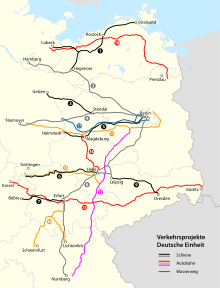Federal Transport Infrastructure Plan 1992
The Federal Transport Infrastructure Plan 1992 ( FTIP 1992 ) was the 1992 valid until 2003 Federal Transport Infrastructure Plan in Germany.
The plan envisaged investments totaling 493 billion DM (around 252 billion euros ) at the price level in 1991. Of this, 194.9 billion DM (39.5%) went to federal railways and 38.8% to federal highways.
It was passed on July 15, 1992 by the federal government . It replaced the Federal Transport Infrastructure Plan in 1985 and was itself replaced in 2003 by the Federal Transport Infrastructure Plan 2003 .
The revision of the Federal Transport Infrastructure Plan presented in 1992 was largely triggered by German reunification and the fundamental changes associated with it.
scope
In the BVWP 1992, the projects contained in the Federal Transport Infrastructure Plan 1985, the projects of the gap closure program and the German unity transport projects were included without re-examination. New projects were subjected to a uniform evaluation according to macroeconomic, ecological and urban development criteria (only for federal highways). In the case of investment projects by the two German railways, a proof of economic profitability also had to be carried out. Due to limited financial resources, only projects with a benefit-cost ratio of at least 3.0 were included in urgent needs . Deviations from this were possible if other criteria were taken into account.
In the urgent need for the railways, the plan contained in the overhang (from the Federal Transport Infrastructure Plan 1985 and the gap-closing program) measures totaling 55.5 billion DM, of which around 20.4 billion DM had been spent by the end of 1992. Around 73.2 billion DM were earmarked for new measures in the rail network. (Prices as of January 1, 1991).
Traffic forecasts
The forecasts assume an average increase in long-distance passenger rail transport between 1988 and 2010 of 40 percent.
The Federal Transport Infrastructure Plan 1992 was reassessed in the second half of 1999. At the end of the 1990s, the forecasts of independent institutes based on the status quo data and for the forecast year 2010 were below the expectations of the Federal Transport Infrastructure Plan. For example, instead of the expected 67 billion passenger kilometers (in 2010), 61 billion were expected in passenger transport. In freight transport, the value fell from 194 to 93 billion ton kilometers. As a result, in mid-1999 Deutsche Bahn adjusted its plans.
Individual evidence
- ^ A b c Hans Peter Weber, Michael Rebentisch: The Federal Transport Infrastructure Plan 1992 for the rail sector . In: Railway technical review . tape 41 , no. 7/8 , 1992, pp. 448-456 .
- ↑ The Federal Minister of Transport (ed.): Bundesverkehrswegeplan 1992 (BVWP '92) . Reprint April 1999, Bonn 1999, p. 4.
- ↑ Wilhelmd Blind: Cologne-Frankfurt (M) in an hour . In: Railway technical review . 41, No. 7/8, July / August 1992, pp. 475-484.
- ↑ Announcement Billion Holes . In: Eisenbahn-Revue International , issue 10, year 1999, p. 401.
- ↑ Notification of major projects on the siding . In: Eisenbahn-Revue International , Issue 9, year 1999, p. 338
